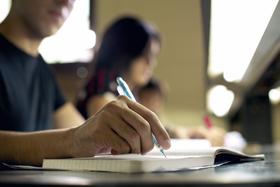Top Rankings
Harper Woods The School District Of The City Of ranks among the top 20% of public school district in Michigan for:
Category
Attribute
Community Size
Largest student body (number of students) (Top 1%)
For the 2025-26 school year, there are 3 public middle schools serving 1,184 students in Harper Woods The School District Of The City Of. This district's average middle testing ranking is 1/10, which is in the bottom 50% of public middle schools in Michigan.
Public Middle Schools in Harper Woods The School District Of The City Of have an average math proficiency score of 7% (versus the Michigan public middle school average of 31%), and reading proficiency score of 15% (versus the 44% statewide average).
Minority enrollment is 78% of the student body (majority Black), which is more than the Michigan public middle school average of 42% (majority Black).
Overview
This School District
This State (MI)
# Schools
7 Schools
1,346 Schools
# Students
2,755 Students
537,178 Students
# Teachers
106 Teachers
31,643 Teachers
Student-Teacher Ratio
28:1
28:1
Student By Grade
District Rank
Harper Woods The School District Of The City Of, which is ranked within the bottom 50% of all 845 school districts in Michigan (based off of combined math and reading proficiency testing data) for the 2022-2023 school year.
The school district's graduation rate of 55% has increased from 54% over five school years.
Overall District Rank
#800 out of 862 school districts
(Bottom 50%)
(Bottom 50%)
Math Test Scores (% Proficient)
5%
35%
Reading/Language Arts Test Scores (% Proficient)
13%
45%
Science Test Scores (% Proficient)
6%
38%
Graduation Rate
55%
81%
Students by Ethnicity:
Diversity Score
0.23
0.60
% American Indian
n/a
1%
% Asian
1%
4%
% Hispanic
1%
9%
% Black
87%
23%
% White
10%
58%
% Hawaiian
n/a
n/a
% Two or more races
1%
5%
All Ethnic Groups
District Revenue and Spending
The revenue/student of $13,381 in this school district is less than the state median of $18,512. The school district revenue/student has declined by 15% over four school years.
The school district's spending/student of $10,416 is less than the state median of $17,694. The school district spending/student has declined by 15% over four school years.
Total Revenue
$37 MM
$25,476 MM
Spending
$29 MM
$24,351 MM
Revenue / Student
$13,381
$18,512
Spending / Student
$10,416
$17,694
Best Harper Woods The School District Of The City Of Public Middle Schools (2025-26)
School
(Math and Reading Proficiency)
(Math and Reading Proficiency)
Location
Quick Facts
Rank: #11.
Harper Academy
Alternative School
(Math: ≤20% | Reading: ≤20% )
Rank:
Rank:
2/
Bottom 50%10
20225 Beaconsfield St
Harper Woods, MI 48225
(313) 245-3084
Harper Woods, MI 48225
(313) 245-3084
Gr: 7-12 | 89 students Student-teacher ratio: 89:1
Rank: #22.
Harper Woods Middle School
Magnet School
(Math: 7% | Reading: 17%)
Rank:
Rank:
1/
Bottom 50%10
19800 Anita St
Harper Woods, MI 48225
(586) 343-1830
Harper Woods, MI 48225
(586) 343-1830
Gr: 6-8 | 349 students Student-teacher ratio: 21:1 Minority enrollment: 97%
Rank: #33.
Harper Woods Virtual Academy
Alternative School
Magnet School
Magnet School
(Math: ≤5% | Reading: 10-14%)
Rank:
Rank:
1/
Bottom 50%10
19872 Kelly Rd
Harper Woods, MI 48225
(800) 297-2119
Harper Woods, MI 48225
(800) 297-2119
Gr: K-12 | 746 students Student-teacher ratio: 149:1 Minority enrollment: 67%
Recent Articles

Charter Schools vs Public Schools 2025: Key Differences & Trends
Explore updated 2025 insights comparing charter schools vs public schools, enrollment, academic outcomes, funding, and real-world examples for families and educators.

Are Public Schools Ready for the 21st Century? 2025 Update
Explore 2025 insights on whether public schools are ready for the 21st century, covering performance, technology, equity, funding, and future-ready learning.

Public School Open House & Enrollment Season Guide
A parent-focused guide to the public school open house and enrollment season, with expert questions, timelines, and decision tips.





